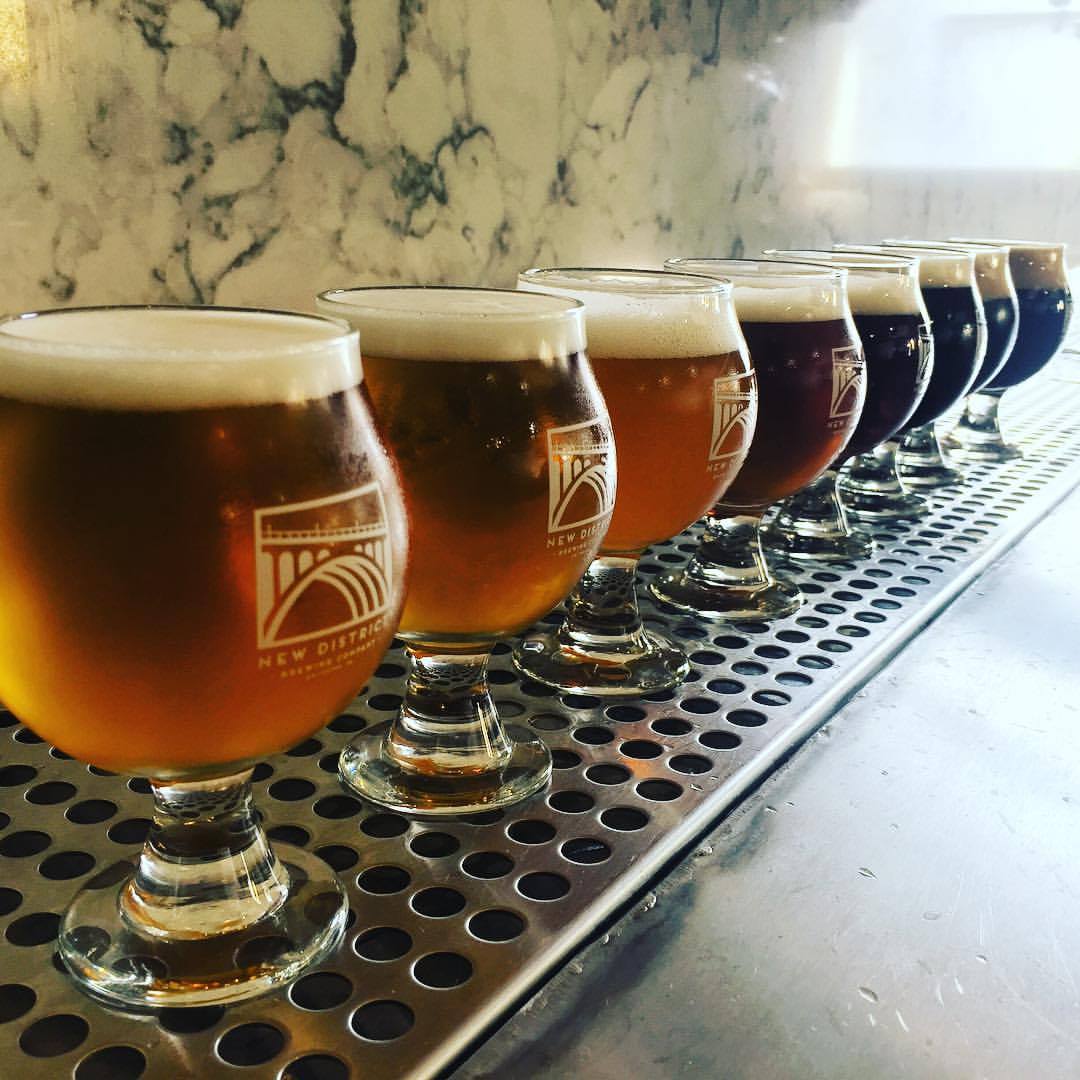By Greg Kitsock
Arlingtonians tend to be highly educated, well-to-do (median family income over $110,000) and, judging from the burgeoning bar scene, perennially thirsty.
So why is Arlington County such a desert for breweries?
Nearby Loudoun County has over 30 breweries serving a population of 398,000. If breweries were parceled out according to population, Arlington ought to have 17 or 18.
In fact, it has an infinitesimal one.
That honor goes to New District Brewing Co. in South Arlington. When it opened in 2016, New District became the first production brewery to operate in the county since Arlington Brewing Co. (also known as Consumers Brewing Co.) gave up the ghost exactly a century earlier.
Situated in Rosslyn near the shores of the Potomac, Arlington Brewing operated out of a towering, red-brick, Gothic-style building with a 150-foot-high smokestack and had a capacity of 100,000 barrels a year. By contrast, New District turned out 550 barrels in 2017, according to Brewers Association figures.
Founder Mike Katrivanos was out of the country when I called, but his father Harry was happy to give “the Reader’s Digest version” of the brewery’s origins. The name “New District” commemorates the fact that Arlington was originally part of the District of Columbia; Congress retroceded the land back to Virginia in 1846, believing the federal government would never need that much land. The brewery’s logo is the Key Bridge, which links Arlington with Georgetown.
Mainstays include 1821, a golden saison brewed with a spice that Mike Katrivanos discovered on a trip to the family’s ancestral home in Greece. The secret spice is also used in New District’s other flagship, 1821 Dark, a strong (8.5% ABV) lager with notes of coffee and chocolate. Recent releases include a ginger saison, a honeysuckle hefeweizen, and a pumpkin ale dubbed Fashionably Late because they waited until the cusp of Halloween to release it.
Besides the brewery taproom, New District beers are available at a handful of accounts in northern Virginia. Growlers (32-ounce and 64-ounce) are currently the only option for takeout, but the brewery is exploring bottling or canning.
When it opened, New District shared Arlington with several brewpubs. The Rock Bottom Brewery in the Ballston Mall elected to pull up stakes in 2016 after most of the mall closed for renovation. Sehkraft, an ambitious brewpub/entertainment venue/butcher shop in Clarendon, shut down after barely a year of brewing. Capitol City Brewing Co. in Shirlington, following a 20-year run, closed abruptly in March.
Preceding these were Blue-n-Gold Brewing Co. in Clarendon (named after the owner’s pet macaw), which operated between 1996 and 1998 at what’s now Mister Days Sports Rock Cafe in Clarendon; and Bardo Rodeo, which became Arlington’s first modern craft brewery in 1993 when it opened in a cavernous former Oldsmobile dealership near the county courthouse.
Bardo morphed into a multitap called Dr. Dremo’s, closing in 2008. Brothers Bill and Andrew Stewart reopened Bardo in 2012 in Washington, DC; the outdoor brewery and beer garden, now shuttered for the winter, is just south of the Nationals Stadium. Asked about their exodus from Arlington, Andrew cites the high commercial lease rates.
“You can see the patterns if you look closely. A business’s lease expires after 20+ years, they do not feel their business plan is suited for $50-per-square-foot lease expense, and they simply close up shop.” Others, like Capitol City, “end up closing a few years into the new lease because what was once a solid business plan has now become untenable.”
Historian Garrett Peck (author of Capital Beer, Prohibition in Washington, DC and other works) is of a similar opinion. “Out in the suburbs and exurbs, there is plenty of space and rents are much lower. Rent is one of the biggest expenses for any brewery, and Fairfax and Loudoun have a big advantage in low rents vs. Arlington. It’s just too pricey to operate here.”
(Depending on whom you talk to, Sehkraft was paying between $45,000 and $60,000 monthly for its prime real estate in Clarendon.)
According to Katrivanos, however, “zoning is the big inhibitor” for production breweries.
Back in the 1890s when Consumers’ Brewing Co. was pumping out beer, ale and porter, what’s now Arlington County was largely rural, with a little over 6,000 residents scatted over a couple unincorporated villages and nearly 400 small farms.
Today, Arlington is an urban community densely packed into 26 square miles. (Trivia buffs might want to take note that it is the smallest self-governing county in the whole nation.) Very little space is zoned for industrial use. It doesn’t help either that the federal government owns 4.6 square miles, about 17% of all the land!
Yet, “Arlington was always the place that Mike wanted to set up his business in,” his father noted, and he spent a considerable amount of time researching neighborhoods in his home town, networking with county officials and pounding the pavement before he acquired his current digs at 2709 South Oakland Street. New District occupies the bottom floor of a facility owned by Henderson’s Moving and Storage Services. “We share a back wall with the Arlington Food Assistance Center,” adds Katrivanos.
It’s not a neighborhood filled with condo dwellers apt to complain about the smell of cooked grain wafting through the air. But it’s not that remote either, adjacent to a dog park (the brewery hosts a Wednesday Dog Club that welcomes canines) and a 5-10 minute walk from the shops at the Village at Shirlington. New District is in the vicinity of both Signature Theatre and Arlington Theatre on the Run. The owners have played up the arts connection by hosting an annual ValleyFest, a street festival showcasing community artists and musicians.
Arlington’s indifference to craft brewing might be changing: this year the Arlington Chamber of Commerce granted New District a Best Business Awards for 2018 Retail Small Business of the Year.
An omen of better times to come?



